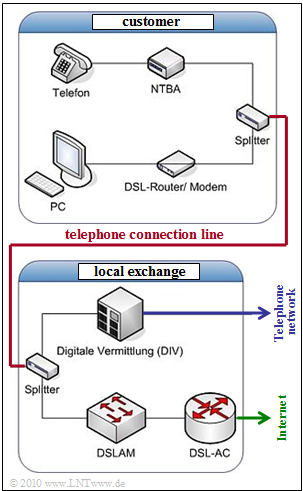Exercise 2.2Z: DSL Internet Connection
From LNTwww
(Redirected from Aufgabe 2.2Z: DSL–Internetanschluss)
The graphic shows a possible configuration of a DSL Internet connection,
- above the subscriber side and
- below the components of the exchange,
which forwards the telephone signals (analog or ISDN) via the digital exchange (DIV) to the telephone network and the data signals to the Internet.
The components on the customer side, viz.
- Splitter,
- NTBA,
- DSL router/modem
are the focus of the following questions.
Hints:
- This exercise belongs to the chapter "xDSL Systems"
Questions
Solution
(1) Correct is the proposed solution 3:
- The splitter is a combination of a high-pass and low-pass filter that handles the separation of the telephone signal (below 120 kHz) from the DSL data signal (above 138 kHz), or their combination.
(2) All statements are correct.
- For more detailed information on the ISDN basic access and especially on the network termination (NTBA), please refer to the chapter "ISDN Basic Access" of this book.
(3) Correct are the suggested solutions 1 and 2:
- DSL systems always use ATM (Asynchronous Transfer Mode) as the basic protocol.
- The customers' terminal equipment, however, usually uses the Ethernet protocol and cannot process ATM cells.
- The protocol conversion is based on the AAL5 protocol (ATM Adaption Layer Protocol 5).
- The subscriber-side xDSL unit is $\rm xTU-R$ (xDSL Transceive Unit - Remote) and is located as a plug-in unit in the xDSL modem or router.
- In contrast, the $\rm xTU-C$ (xDSL Transceive Unit - Central Office) is located in the DSLAM (Digital Subscriber Line Access Multiplexer) in the exchange or in the cable distribution frame, i.e. on the network operator side.
